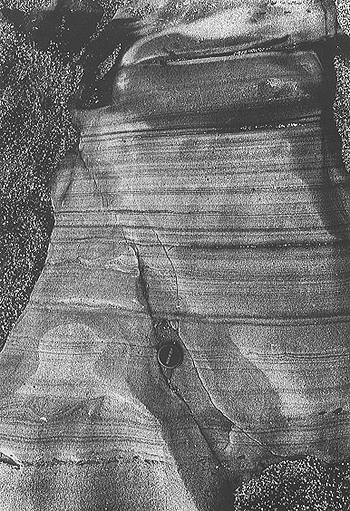
Plane-parallel laminae in turbidite sandstone
Plate 42

Plane-parallel laminae in turbidite sandstone
Plate 42
The accreting surface is horizontal in this case, too, and the laminae very similar to the ones shown in plate 40. The environment of deposition was, however, completely different: a deep sea bottom, normally covered by mud but occasionally invaded by sand carried by a turbidity current. This shows us that planar lamination indicates a certain hydraulic condition (tractive flow in upper flow regime, phase of plane bed), which can occur in different environments of deposition. Therefore, it is an indicator of process, or mechanism, not of environment.
You may have remarked that plane-parallel lamination is not the only structure displayed by this picture. Other features are: 1) a vertical size grading in the lower part of the bed; 2) the presence, at the same level, of aligned dark fragments of pebble size: they are chips of clay or mudstone; 3) some sets of laminae (at least three) show undulations and small cusps: these are deformations, probably induced by water escaping during deposition. Although not dominant and eye-catching, the above mentioned characters are significant: they give us more information concerning the process. The grading and the deformed laminae, for example, indicate relatively rapid deposition, which rules out a "particle by particle" accretion; the clay chips reveal that, not far from here, a muddy bottom was eroded by the agent responsible for deposition. All this makes us think of a possible catastrophic process; not one of too high particle concentration, anyway, because the well-developed lamination clearly indicates traction, and we know that traction is ineffective if sedimentation is too quick. Without other independent evidence, however, we can just suspect, but not prove, that this is a turbidite. Catastrophic processes, like storm waves and currents, operate also in littoral and shelf environments.
The sandstone outcrop is part of the Franciscan
Complex along the California coast.